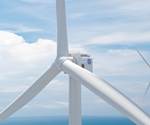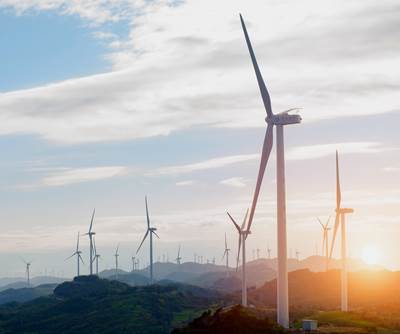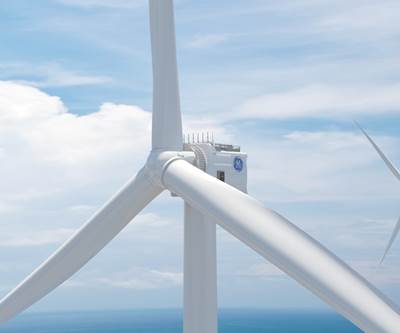Wind turbine blades: Glass vs. carbon fiber
As the wind energy market continues to grow, competition heats up between glass and carbon fiber composites for turbine blades.
From its inception, the wind energy industry has had to fight to compete with other forms of electric power generation. Wind energy producers not only face that battle, but also wage war against each other for a competitive share in the wind market. Both battles boil down to a need to improve the economics of wind energy through increased energy capture. This has prompted a well-documented growth spurt in the size of turbines and rotor blades for land-based and offshore systems (see “Wind turbine blades: Big and getting bigger,” under "Editor's Picks," at top right). Offshore turbines are moving quickly from 3 MW to next-generation turbines rated at 5 MW and larger, on which blade lengths for both on- and offshore systems regularly exceed 45m/148 ft. As blades grow longer, the idea of converting structural areas of the blade from E-glass to significantly stiffer and lighter carbon fiber begins to make sense, despite the latter’s greater upfront cost.
Carbon fiber already has proven to be an enabling technology for turbine manufacturers Vestas Wind Systems A/S (Aarhus, Denmark) and Gamesa Technology Corp. (Zamudio, Vizcaya, Spain). Both companies embraced carbon fiber years ago, using it in select structural parts of their blades and taking advantage of the lighter weight blades throughout the turbine system. Lighter blades require less robust turbine and tower components, so the cascading cost savings justify the additional cost of carbon. “Vestas and Gamesa designed their turbines around the use of carbon fiber and, by virtue of that, the whole system cost is less than a system with an all glass-fiber blade,” confirms Dr. Philip L. Schell, executive VP of wind energy at carbon fiber manufacturer Zoltek Corp. (St. Louis, Mo.).
And that is before the increase in turbine efficiency that additional length enables. For example, the switch to carbon fiber enabled Vestas, initially, to add 5m/16 ft in blade length without any additional weight gain. The Vestas V112-3MW turbine is designed for low- and medium-wind areas and sports three 54.6m/179-ft blades. These blades have the same width as the company’s 44m/144-ft blades, but they sweep an area that is 55 percent larger. The result is considerably higher energy output.
More recently, GE Energy (Greenville, S.C.) joined the fray, specifying carbon fiber in its next-generation wind blades, including the 48.7m/160-ft blades for its 1.6-100 turbine. Yet, speaking at CompositeWorld’s 2011 Carbon Fiber conference in Washington D.C., Nirav Patel, senior lead engineer of GE Energy-Manufacturing Technology, issued a warning that carbon fiber cost and supply concerns could be showstoppers to further use of carbon fiber in GE applications. Patel also called for increased automation and improvements in manufacturing processes (see “What is carbon fiber's place in wind energy systems?” under "Editor's Picks").
Notably, it may be GE’s use of carbon fiber to increase blade length on its 1.6-MW system that will ultimately push more wind energy companies to embrace carbon fiber. “GE’s decision to put a 100m [328-ft] diameter rotor on a 1.6-MW turbine has captured the attention of a lot of companies in the industry,” says Dr. Kyle Wetzel, president, Wetzel Engineering (Lawrence, Kan.), which designs wind turbines and rotors. “As a result, we are being approached by a number of companies that want to similarly upsize their machines.”
A carbon backbone
Retrofitting existing turbine designs with longer blades that incorporate carbon has become a shortcut to marketability. “It’s always best to do a system-level design — treating the rotor, the turbine, and the tower as one system — but the reality is that the energy market is so competitive and everyone is so worried about what their competitors are doing, that they often don’t have time to do a system-level design,” explains Wetzel. “So, if a company decides to go to an extremely large blade on an existing system, then carbon fiber becomes an enabling technology by allowing for increased blade length without increased weight.”
Currently, carbon fiber is used primarily in the spar, or structural element, of wind blades longer than 45m/148 ft, both for land-based and offshore systems. The higher stiffness and lower density of CF allows a thinner blade profile while producing stiffer, lighter blades. The rough rule of thumb for weight reduction, offers Schell, is at least 20 percent weight savings when moving from an all-glass blade to one with a carbon fiber-reinforced spar cap. Offshore wind systems — where the smallest turbines are rated at 3 MW — will especially benefit from the characteristics of carbon.
“Assuming that offshore continues in its positive direction and costs remain under control, I wouldn’t be surprised to see 8-MW to 10-MW turbines with 80m to 100m [263-ft to 328-ft] long blades in the next three to five years,” says Schell.
“A 100m blade made entirely out of glass fiber could weigh up to 50 metric tonnes [110,231 lb],” he notes. “When you consider achieving a 20 to 30 percent weight savings by incorporating carbon fiber, that’s a weight savings of 15 metric tonnes [33,069 lb]. Multiply that by three and it can make a significant difference,” Schell stresses.
“In a 100m blade, the weights get so high that we are starting to investigate using carbon in the skins of the blade for added weight reduction,” says Wetzel. In a conventional, land-based blade design, however, the spar cap is the only area where Wetzel would recommend CF, but Schell notes that one company is using a hybrid glass/carbon reinforcement in the root section of the blade.
“In some very specialized blades, we’ve incorporated carbon in the trailing edge in an effort to tune some of the natural frequencies of the blade,” says Wetzel. “And carbon could come into play in aeroelastic tailoring,” he adds, noting that the idea is to build a small amount of twistability into the load response of a blade with asymmetric fiber layup in the blade skin to shape the power curve and reduce loads. “It’s a concept that’s been around for about 10 years, but I think it’s going to soon find its way into some commercial wind blades — very large blades.”
Glass-to-carbon challenges
Replacing E-glass with carbon fiber brings new processing challenges as well. Carbon has a relatively low damage tolerance, and its compressive strength is greatly affected by fiber alignment. Further, molders encounter greater difficulty in achieving fiber wetout during vacuum infusion; given this, wind blade manufacturers have tended to use more expensive prepreg products.
“We’ve seen significant improvement in the last few years regarding the compressive strength of carbon prepreg materials in the fiber direction, and a lot of that has come from improved manufacturing and prepreg processes,” says Wetzel. “However, great strides still need to be made in that area with fiber alignment,” he adds.
“Carbon requires perfect fiber alignment, and must be cured quickly,” explains Manfred Schoeflinger, business development manager for wind energy at Hexcel (Stamford, Conn.), which has been supplying composite materials for wind blades for more than 20 years. Even small misalignments can lead to a significant reduction of compressive and fatigue strength.
Hexcel’s trademarked HexPly unidirectional (UD) carbon fiber prepregs feature a patented grid technology that assists in removing air during the vacuum-bag processing of thick carbon UD laminates. A low void content improves mechanical performance by ensuring that the carbon fiber properties are translated to the laminate. Grid technology is incorporated into the company’s HexPly M19G carbon fiber UD prepreg, which cures 15 to 20 percent faster than Hexcel’s standard-cure product. Less energy is required to cure M19G, which is suitable for blade shells, spars and root ends.
Automatic ply placement also improves quality. Generally, spar caps may require 45 to 50 plies of prepreg, but as the blade size grows, structures may require 100 plies or more. “Trying to lay 80 plies of prepreg, one on top of the other, in a spar cap tool that’s 180 to 200 ft [36.6 to 61m] long and 600 mm [23.6 inches] wide, would be a challenge to anyone,” says Schell. Which is why Zoltek, through its subsidiary Entec Composite Machines (Lake City, Utah), offers a fiber alignment system specifically designed to mount onto a spar cap tool. “The machine automatically deposits each ply of prepreg into the tool in the proper location with the right tension and alignment,” explains Schell.
“Fabric is more challenging,” he adds. “We’re looking into ways of applying fabric into a tool using a similar device, and we expect to introduce that within 2012.” In general, fabric, which does not have the tack of prepreg, requires a slightly different approach and machine technology.
Another area in need of improvement, in Wetzel’s opinion, is fracture toughness. “The fracture toughness mostly relates to the resins that are being used and the resin/fiber interactions, but it very strongly affects the fatigue life of the parts and delamination of the layers,” he explains. “We’re looking for nearly a doubling in fracture toughness from what we’re typically seeing right now.”
Supply and demand
Because of the sheer quantity of standard-modulus carbon fiber required for these increasingly large wind blades, blade manufacturers are likely to eclipse aerospace manufacturers in carbon fiber consumption during the next 10 years. Chris Red, owner and president of Composites Forecasts and Consulting (Gilbert, Ariz.), has predicted that by 2019, the world will produce 27,000 wind turbines and 82,000 blades, and carbon fiber will comprise 6 percent of all composites in each blade (see “Carbon fiber market: Gathering momentum,” under Editor's Picks").
According to Patel, GE plans to use 24K or greater standard-modulus carbon fiber to form the primary structures of 1,600 next-generation 48.7m/160-ft blades. He also claims that in 2012 alone, GE Energy expects to consume about 3,000 metric tonnes (about 6.6 million lb) of carbon fiber. The concern voiced by GE and others looking to add carbon fiber to blade designs is Will there be a reliable supply of large-tow, standard-modulus fiber as demand ramps up?
“Consistency in terms of fiber supply, capacity and price is certainly a concern for the industry,” says Schoeflinger, but he’s optimistic: “There will be two carbon fiber markets emerging — one focusing on aerospace and one focusing on industrial applications.”
Schell agrees, noting, “I think it’s more a problem of the past.” Zoltek, in fact, has thrown all its cards into the industrial sector, building its business around supplying standard-modulus carbon fiber products (rovings, prepregs and fabrics) to not only the wind energy industry but the automotive industry as well. Zoltek currently has 20,000 metric tonnes (about 44.1 million lb) of carbon fiber installed in wind turbine blades worldwide.
“Zoltek has ample supply capacity, with the ability to increase and ramp up that capacity very quickly as demand rises,” Schell claims, but he acknowledges that fears about inadequate supply have, in the past, been warranted. “Ample carbon supply is certainly a concern when you switch to a less readily available product,” he adds, “but I think it’s much less of an issue today.” Schell says Zoltek now has >13,000 metric tonnes (about 28.6 million lb) of industrial-grade carbon fiber capacity with plans to “dramatically” increase capacity over the next five years, mainly in support of wind energy.
Wetzel, on the other hand, believes the days of supply shortages and price volatility are not a thing of the past. “We have a lot more capacity in carbon supply than we did five or six years ago, but we also have a worldwide recession suppressing the demand for carbon fiber,” he says. “And once aerospace takes off significantly and wind, and on top of that offshore, I think we can expect a significant increase in demand for carbon fiber, and I doubt suppliers will be ready for it,” he warns. He speculates, however, that it may be more of a problem for the high-quality, high-modulus (aerospace-grade) products used in aircraft.
Supply concerns and the high price of carbon fiber, which costs 10 to 20 times as much as E-glass, will likely continue to make some manufacturers hesitate before designing a new blade with CF. “One of our customers has designed a blade in two options,” says Gary Kanaby, director of sales for wind energy, Molded Fiber Glass Cos. (MFG, Ashtabula, Ohio). “It can be built with or without carbon.”
LM Wind Power (Kolding, Denmark) is one of several blademakers that is finding ways around the use of carbon in large blades. The company recently installed 73.5m/240-ft glass-fiber/polyester blades on a 6-MW turbine off the coast of France (see the sidebar below, titled “Competition for carbon fiber in wind blades”).
Competition in the global wind energy market is fierce, however, especially in China, where dozens of companies are fighting for a piece of the world’s leading wind market. Those players will gravitate to materials and processes that can offer them a competitive edge. Kanaby believes more and more carbon will be used in next-generation wind blades. However, he says the factor that will most dictate the use of carbon in a turbine rotor will be the spreadsheet. “It doesn’t really matter what it’s made out of when it’s spinning,” he says. “It just needs to make money.”
Related Content
Honda begins production of 2025 CR-V e:FCEV with Type 4 hydrogen tanks in U.S.
Model includes new technologies produced at Performance Manufacturing Center (PMC) in Marysville, Ohio, which is part of Honda hydrogen business strategy that includes Class 8 trucks.
Read MorePolar Technology develops innovative solutions for hydrogen storage
Conformable “Hydrogen in a Box” prototype for compressed gas storage has been tested to 350 and 700 bar, liquid hydrogen storage is being evaluated.
Read MoreInfinite Composites: Type V tanks for space, hydrogen, automotive and more
After a decade of proving its linerless, weight-saving composite tanks with NASA and more than 30 aerospace companies, this CryoSphere pioneer is scaling for growth in commercial space and sustainable transportation on Earth.
Read MoreAchieving composites innovation through collaboration
Stephen Heinz, vice president of R&I for Syensqo delivered an inspirational keynote at SAMPE 2024, highlighting the significant role of composite materials in emerging technologies and encouraging broader collaboration within the manufacturing community.
Read MoreRead Next
Wind energy: Gale force growth ahead
Columnist Dale Brosius addresses recent accomplishments, forecasts and recycling challenges affecting the wind energy industry — and composites use within it.
Read MoreGE to develop largest, most powerful wind turbine
The Haliade-X will feature a 12 MW direct drive generator and 107m-long blades.
Read MoreDeveloping bonded composite repair for ships, offshore units
Bureau Veritas and industry partners issue guidelines and pave the way for certification via StrengthBond Offshore project.
Read More





















